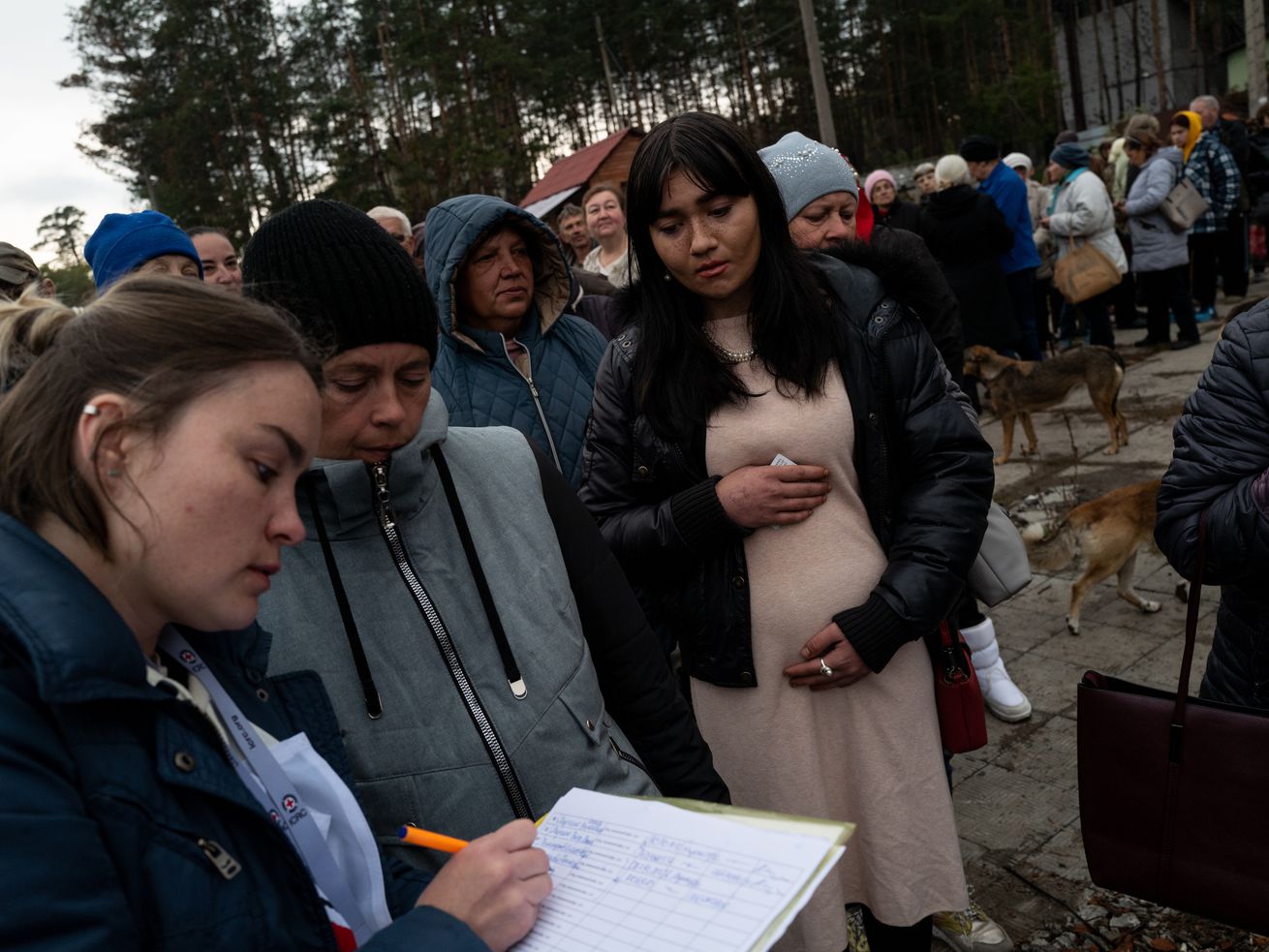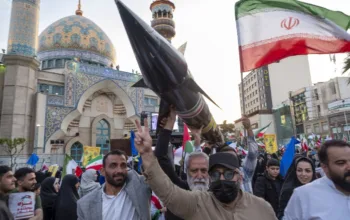Moscow’s next target may be a massive dam in Kherson.
Ukrainians in the south of the country are bracing for the likely destruction of a major dam that would have immediate and catastrophic consequences for civilians in the area. Ukraine has pointed to the likely attack on the dam, located in Kherson Oblast, as part of Russia’s increasing use of an illegal but practiced tactic — attacking civilian infrastructure.
Though Russia has used this strategy before, both in Ukraine and in previous wars in Chechnya and Syria, there has been a notable uptick in the rate at which Russian forces have been attacking civilian infrastructure including energy facilities and water supplies after Ukraine’s stunning counteroffensive in Kharkiv Oblast in September.
The Kakhovka Hydroelectric Power Plant, which spans the Dnipro River in the southern port city of Nova Kakhovka is a particularly sensitive target. Russian forces are expected to attack the dam as part of their withdrawal from Kherson Oblast and then pin responsibility on Ukraine, according to a report on Friday from the Institute for the Study of War (ISW). As Ukrainian President Volodymyr Zelenskyy pointed out Thursday, attacking the dam will cause severe flooding to populated areas along the Dnipro River, including the city of Kherson itself.
It could also seriously jeopardize the functioning of the embattled Zaporizhzhia Nuclear Power Plant (ZNPP), which is Europe’s largest and depends on water from the Khakhovka plant to cool the nuclear fuel there. Without water to cool the fuel and electricity to pump the water into the facility, nuclear fuel overheats and can cause disasters like a spent fuel fire.
ZNPP has been in an extremely vulnerable position since Russia took over the plant in March; the Ukrainian staff operating the facility have been essentially held hostage and heavy shelling in the vicinity of the plant raised international concern of a possible nuclear disaster.
The potential attack on the Khakovka facility, which is likely tied to Russia’s retreat from the area according to the ISW. “Russia… has every reason to attempt to provide cover to its retreating forces and to widen the Dnipro River, which Ukrainian forces would need to cross to continue their counteroffensive,” thus impeding the Ukrainian forces’ ability to push further into Russian-held territory, the ISW’s Friday report assessed.
But such an attack, like so many others Russia has been executing throughout the war, will have serious, long-lasting consequences for the civilians left in its wake, in addition to slowing down Ukrainian troops.
This tactic is creating a dire humanitarian crisis that could last for years
As winter arrives in Ukraine, Russia’s attacks on energy facilities like Khakovka will put civilians at risk; without power to heat their homes and prepare food, they’ll be vulnerable to conditions like frostbite and malnutrition — injuries that are already occurring, Aaron Epstein, the president of the Global Surgical and Medical Support Group (GSMSG) and a surgical resident at the University of Buffalo, told Vox in an interview Saturday.
“It’s not so much direct impacts of [Russian forces] attacking a certain area,” Epstein, whose group provides training and technical assistance to medical professionals and civilians in war zones, told Vox. Now, the illnesses and injuries civilians are sustaining are likely due to the loss of infrastructure, he said. Civilians are certainly still being injured in attacks like the kamikaze drone strikes in Kyiv, but the broad effects of infrastructure attacks are unfolding in less dramatic, but no less critical ways.
“I think we’re starting to see a much larger scale of problems from a health standpoint that may not be a direct blast, penetrating injuries, burn injuries — it’s now population-wide in terms of loss of infrastructure problems, so I think that’s the more noticeable impact of what’s been going on lately,” he said.
Before Russia ramped up the attacks on civilian infrastructure, “we would see military-aged males, injured in combat with blast and shrapnel injuries,” Epstein said. “You would occasionally see the civilian population — the usual spread, women, children, and elderly — that may have gotten hit with just a missile, or something that hit a civilian area. Or, if it was a town that was being attacked by the Russians and they were trying to obliterate everything within the town, then it was just a spread of everybody coming in with blast and shrapnel and burn injuries.”
Now, though, “frostbite, or cold, or malnutrition, or even just GI [gastrointestinal] related illness that goes prolonged and untreated” are becoming more common, likely due to lapses in critical infrastructure, Epstein said. Many victims now look like “the elderly grandmother who’s sitting in her apartment, just trying to wait out the war [and] suddenly has no power for a week, or suddenly has no clean water,” he told Vox.
Epstein’s group, he said, is helping teach civilians and medical professionals in Ukraine about treating injuries like frostbite, and will likely incorporate wilderness survival training like starting fires and purifying drinking water to help civilians prepare for life without reliable heat, electricity, and clean water, he told Vox.
The knock-on effects that such destruction has — illness from a lack of sanitation facilities or clean drinking water, for example, or disrupted access to medical care due to power outages — can persist in conflict zones, often due to displacement, Sahr Muhammadally, director for MENA & South Asia at Center for Civilians in Conflict (CIVIC), told Vox. “The subject matter [and] technical expertise leaves,” so there’s no one to repair the damaged infrastructure. Ukrainian cities have demonstrated quite a bit of resilience so far, she told Vox, repairing damaged facilities and restoring access to critical services as quickly as possible, “but as this goes on it will be interesting to see what continuing toll is going to be on the response.”
A critical component of the Ukrainian war effort — and Western nations’ support for it — is nonlethal aid. The US has so far given $17 billion in tactical and weapons system aid for Ukraine, which is undoubtedly crucial in helping the armed forces repel Russian troops from their territory. But nonlethal aid like medical supplies is equally important, as medical professionals involved in the Ukrainian war effort told reporters at a panel discussion held by the American College of Surgeons on October 19.
Hnat Herych, chief of surgery department, Multidisciplinary Clinical Hospital of Emergency and Intensive Care, Danylo Halytsky Lviv National Medical University hospital said that his staff had to re-sterilize needles for sutures because they lacked sufficient supplies. “Before the war, I want you to understand, we [did] modern operations, we [had] a da Vinci robot,” he told the panel on Wednesday. “But the war changed everything.”
Attacks on critical infrastructure are part of the Russian playbook
Russia’s blueprint for the escalated attacks on civilian facilities is clear from campaigns in Chechnya and Syria; Grozny, the Chechen capital, was so devastated after the 1999 Battle of Grozny against Russian forces that the UN called it the most destroyed city on earth. In Syria, Russian forces deliberately hit medical targets like hospitals, and even medical workers themselves.
Civilian infrastructure like energy facilities can be legally complex targets under international humanitarian law, though, because they can be considered dual-use facilities. As Muhammadally told Vox, “critical infrastructure or civilian objects should not be targeted under the law of armed conflict, under IHL.” But services and facilities that civilians rely on — like a power station “can be dual-use, they can be used by the military and then they could qualify as a military objective under IHL because by their nature and location, they’re making a contribution to military action.”
But even if such a facility can reasonably be considered a legitimate military target, aggressors still have to make proportionality calculations and consider the effect that the weapons used could have on civilians. So it might be permissible to blow a fuse or otherwise cause technical damage to a power plant that an opposing force is using, but destroying it with an electrical charge or a rocket attack could reasonably cause civilian casualties. “[Military actors] should not be trying to degrade critical infrastructure, unless that’s part of your war strategy,” Muhammadally said; but if that’s the case, “you run afoul of the legal principles.”
Despite likely violations of international humanitarian law, Russia doesn’t seem likely to stop doing this; it’s a psychological tactic, meant to destroy Ukrainians’ will to keep fighting, as well as a siege-like method of depriving them of essential services.
But according to Epstein, though Russian forces continue to target medical facilities, the medical professionals he’s worked with have gotten adept at operating inconspicuously; they’re housing medical facilities underground or in nondescript buildings and eschewing ambulances in favor of low-profile SUVs. Medical personnel and civilians are also bringing their families to GSMSG’s trainings.
“We’re literally training kids how to put on tourniquets because enough people wanted the rest of their family to know how to take care of them in case they were injured, or their kid was the only one left alive in a building,” Epstein said.
“These people feel like they’re facing an existential threat, and they want something better for their kids — they want their kids to survive.”
Author: Ellen Ioanes
Read More



